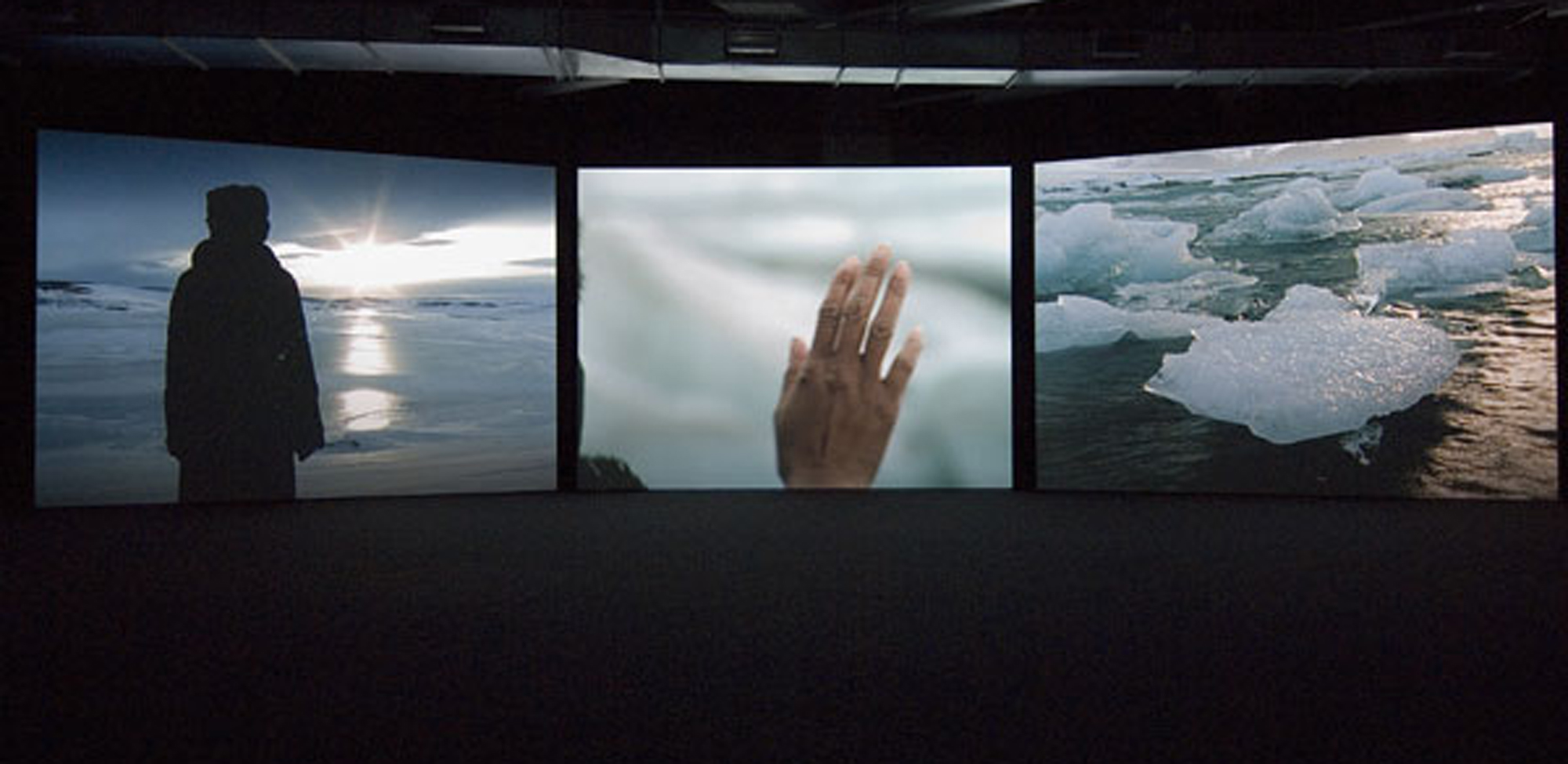Isaac Julien: True North
Curated by Victoria Lynn
9 March 2007 - 21 April 2007

Isaac Julien, True North (installation view), 2007.
Isaac Julien’s three-screen synchronised film installation, True North, 2004, is a meditation on the treacherous and complex journeys beckoned by the sublime and contested space of the North Pole. Julien’s camera is at times continuous across the three screens, and alternately, sliced into a triptych, suggesting the multiple ways in which 'land' is perceived and, literally, apprehended. At one moment, the camera literally seems as though it is falling through the cavernous cracks in the ice, the sequences changing abruptly. At another, the shifting planes of the three screens meet in absolute harmony. Then one plane will slide behind another, or a screen is 'turned off' as it were, fading to black and allowing for iconic moments and singular images. The very real treachery of the ice is played out in these metaphorical slippages, suggesting both the elusive nature of 'true north' and the highly fraught notion of truth itself.
Julien has, for a number of years, been a forerunner in the use of parallel montage. Works such as Paradise Omeros (2002), Baltimore (2003), and Fantôme Créole (2005) explore issues of black identity across multiple screens. This principle of montage – the repetition, mirroring, doubling and interchanging of individual shots – emphasises at a technical level Julien’s idea that memory is non-linear. In relation to True North, he says, “the idea of 're-memorizing’ is different from the official discourses of History with a capital 'H'. A lower-case investigation into the historical material is at work in True North. Memory is not chronological.” Historical memory is juxtaposed with contemporary imagery, and is thus revealed to be increasingly unreliable. The promise of existential uncertainty in the face of the snow-covered, icy and sublime landscape, (a clear reference to the tradition of 19th century sublime landscape painting, for example the works of Caspar David Friedrich) is continually undermined by the non-linear format of the work.
Shot in Iceland and Sweden, the film responds to the story of Matthew Henson, an African American, who took part in Robert Peary’s expedition to the North Pole in 1909, and who was the first person to reach the geographic North Pole, True North, (as opposed to the magnetic North Pole). The minimal voiceover in Julien’s film, which has the intimacy of a whisper, replays the tension between these two men which escalated to the point at which Henson, motivated by fear, had to remove the ammunition from his rifle at night and bury it in the snow. The men had a mutual dependence, however, with a respective double and constantly changing index.
The 'conquest', mapping and surveying of the world is a white undertaking – it is, in other words, colonisation. By casting the role of 'explorer' in the guise of a black woman, Julien contradicts the ideology of colonialism, which is assumed to be both white and male. At the same time he opposes the ideology of 'terra nullus' by making it obvious that the utmost north is inhabited, and that 'conquest' is therefore also always a form of theft. For example, Inuit men and women at work in the landscape are juxtaposed with a Christian church interior, hinting at the disputed histories of this location.
In True North, representation itself is revealed to be both an aesthetic and political challenge. The blazing beauty of white ice and the sonic thunder of the falling water is visualised as a paradoxical space. As the imagery shuttles between telescopic and panoramic journeys, the female subject of the film is simultaneously 'at home' in her icy environment, and at other times engulfed by it. In True North, Julien creates a new kind of topography in which black identity is not aligned to the nation state. Working to disrupt historical assumptions of colonisation and the aesthetic rules of the moving image itself, Julien invokes a fluctuating and experiential interpretation of the voyage.
True North is a part of Turbulence, the 3rd Auckland Triennial. The Auckland Triennial has rapidly established itself as New Zealand’s premier international contemporary art event. Held every three years, it provides a window onto the world of contemporary art, creating a dialogue between local artists and their global counterparts.